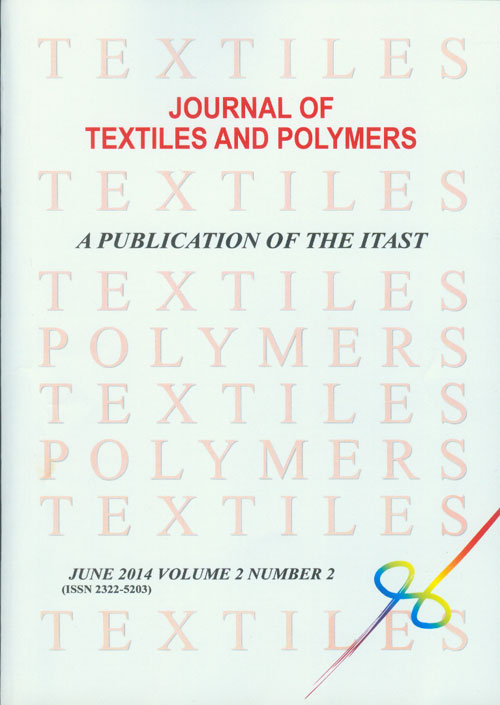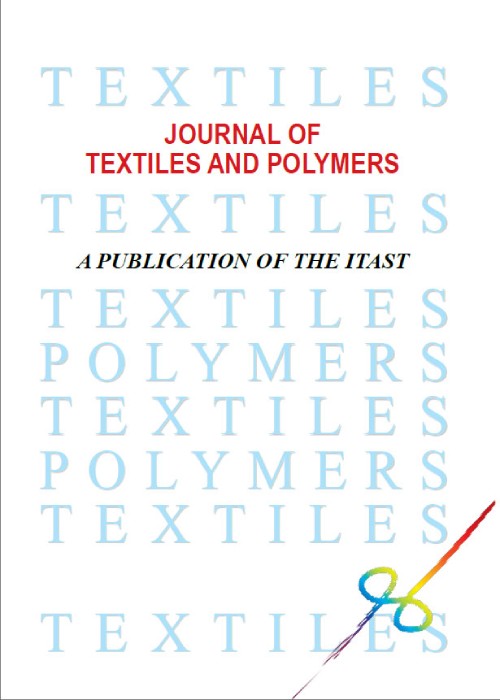فهرست مطالب

Journal of Textiles and Polymers
Volume:2 Issue: 2, Spring 2014
- 82 صفحه،
- تاریخ انتشار: 1393/11/08
- تعداد عناوین: 7
-
-
Page 45The effects of hollow glass fibers (HGF) on tensile and compression strength and bulk properties of polymeric composites have been studied. In this research, the improvement of impact behavior of composites using hollow polyester fibers is investigated. The damage tolerance of composites reinforced by unidirectional hollow ductile fibers is compared with solid fibers reinforced composites under drop weight impact tests. It is found that hollow fibers composites despite the lower modulus in comparison to solid ones are more impact resistant. It is also found that the force at the crack initiation of composites composed of hollow fibers is 9.5% higher than the other one. It is notable that the damage tolerance is increased to 71% in the hollow fiber specimens.Keywords: Hollow fiber, composite, crack initiation, impact behavior, absorbed energy
-
Page 51The purpose of the current work is to examine the universality of the color emotion dimensions for singlecolors. Different scales in color emotion are investigated for single colors in CIELAB color space within a psychophysical experiment. The current work, in which ten word pairs were applied, is a development of the Ou’s study among Iranian observers. The applied word pairs are “Warm-Cool”, “Active-Passive”, “Like-Dislike”, “Clean-Dirty”, “Fresh- Stale”, “Modern- Classical”, “Heavy-Light”, “Hard-Soft”, “Tense-Relaxed” and “Masculine-Feminine”, which are translated into Persian, accordingly. The psychophysical experiment is carried out by forty Iranian university students. All of the observations are divided into two groups of “male” and “female” as well as two cultural groups in Iran and the effect of gender and culture are investigated. Data are analyzed using the method of factor analysis (FA). Three factors are extracted, accounting for 91.8 % of the total variance among Iranian. Color emotional dimensions of Iranians are divided into three categories, namely, Color Activity, Color Weight and Color Heat. These three color emotional dimensions agree well with the ones in the Ou's models. Results show that there is no significant effect of gender and culture on Iranian color emotionalresponses. The results of the present research are compared to the results in the Ou's research, and it is shown that the correlation coefficients values between color emotion scales are equal or more than the ones obtained in the Ou’s research. Also, the relationship between the color emotional responses of Iranian, British and Chinese, reported by Ou [5], are obtained using correlation coefficients (r). Apart from “Like-Dislike” and “Tense-Relaxed” color emotion scales, there is a good agreement between different emotional responses of Iranian, British and Chinese observers.Keywords: Color emotion, single color, British, Chinese, Iranian
-
Page 56This work exploits the concentrated loading method (C.L.M) for the evaluation of woven fabric formability. A total of 21 randomly selected woven fabrics are tested by Lindberg and C.L.M methods and the results are compared. The correlation between calculated formability (bending rigidity/low initial modulus) and the measured features extracted from the concentrated loading curves indicates the possibility of measuring of formability of woven fabrics by C.L.M. Among the features extracted from the concentrated loading curves, the initial slope of the load extension curve (IS), the ending slope of the unloading curve of the concentrated loading method (ES) and the gap area below the buckling (GABB) are highly correlated to the calculated formability of the fabrics. The correlation results indicate that testing the fabric samples under C.L.M can be used for direct estimation of the formability of the woven fabrics without requiring two different laboratory testers (bending and tensile).Keywords: Concentrated loading method, bending rigidity, shear deformation, fabric compressibility
-
Page 60In this study, the possibility of producing silk nanopowder by a commercial proteolytic enzyme in combination with a mechanical treatment is investigated. Different conditions are applied in order to investigate the effects of enzyme concentration and treatment time. The SEM photographs show that the particle size of the produced silk powder is mostly less than 100 nm. The prepared powder is then blended with polypropylene (PP) in different percentages for producing composite films. The SEM micrographs indicate that silk nanoparticles distributed uniformly in the film. Characteristic peaks of both silk andPP are found in FTIR spectra and thus no obvious chemical changes occur during the blending. With the increase in the ratio of the silk powder, there is an evident decrease in the tensile strength and elongation at break. However, silk powder plays an important role in improving the moisture absorption of the films.Keywords: Silk nanopowder, enzymatic treatment, nanocomposite, Polypropylene (PP)
-
Page 65In the recent paper [1], the Benltoufa theoretical model was improved to estimate the three dimension (3D) porosity of plain weft knitted fabric while was subjected to extension under different uniaxial extension in course direction. In addition to this model, there are only a few geometrical models for estimation of 3D porosity of weft knitted fabrics such as Benltoufa and Karaguzel models. In the present research, plain knitted fabrics over a different range of knitting stiffness are produced to investigate the accuracy of these models. Thereafter, the estimated 3D porosities of the fabrics using the theoretical models are compared with the experimental values which are obtained from Guidoin empirical model while is subjected to extension under different uniaxial extension in wale direction. It is concluded that Karaguzel and i-model models show reliable and trustful result while, Benltoufa model shows huge differences in comparison with Guidoin model.Keywords: Three dimension porosity, plain weft knitted fabric, wale extension
-
Influence of Solvent/Polymer Interaction on Miscibility of PMMA/PCL Blend: Thermal Analysis ApproachPage 71The aim of the present work is to probe the influence of solvent on miscibility behavior of a blend of poly(e-caprolactone) (PCL)/Poly (methyl methacrylate) (PMMA). PMMA/PCL blend with mass ratio of 50:50 is employed to prepare the solutions of three different solvents including tetrahydrofuran, toluene and dichloromethane. At the equilibrium situation, the separated phases are cast by film multi-applicator for solvent evaporation and analyzed using thermal analysis (DSC and DMA) approaches. According to the results, the solvent is able to change the saturation value of PCL into the PMMA-rich phase by changing the free energy of the mixture. Through the PCL melting enthalpy as well as the glass transition of PMMA, the capability of PMMA-rich phase for dissolving the PCL and vice versa is investigated. To realize the influence of solvent for these variations, Hansen solubility parameter of components is considered to analyze. It is shown that glass transition of PMMA can be reduced to low values of about 50 °C as a result of solvent-induced miscibility with PCL at room temperature which is not easily achievable by otherprocesses.Keywords: Poly (methyl methacrylate), poly(e, caprolactone), solvent, induced miscibility, thermal analysis
-
Page 79The purpose of this study is to investigate the behavior of the sliver pick-up from can in gill-box machines during feeding process. A model is presented to predict the height changes of can plate during the feeding process. To this aim, a mass-spring model is introduced. The behavior of the can plate is considered as linear spring system and the sliver weight in the can is also noted as time depended mass value. The mass spring derived equations are solved using Three-order Straight Forward Expansion method. Result of can plate height predicting by the model is compared to some experimental data which are collected from a wool yarn mill. The meaningful 12 percent difference between proposed model and the experimental value proves the acceptable result of desired model that can be used for predicting the height of can plate by the aim of machine speed and sliver count.Keywords: Can, gill, box, mass, spring model, straight forward expansion


